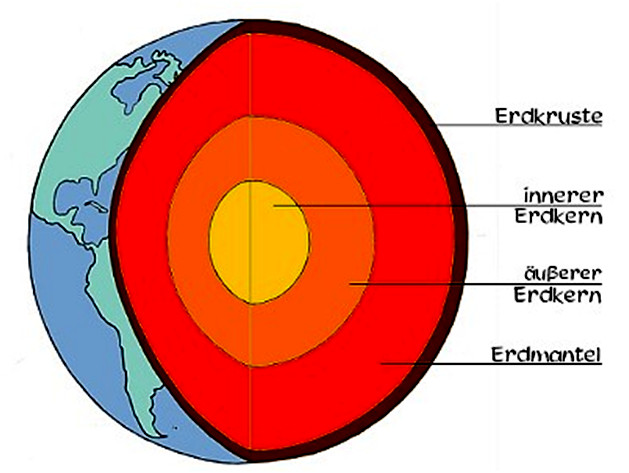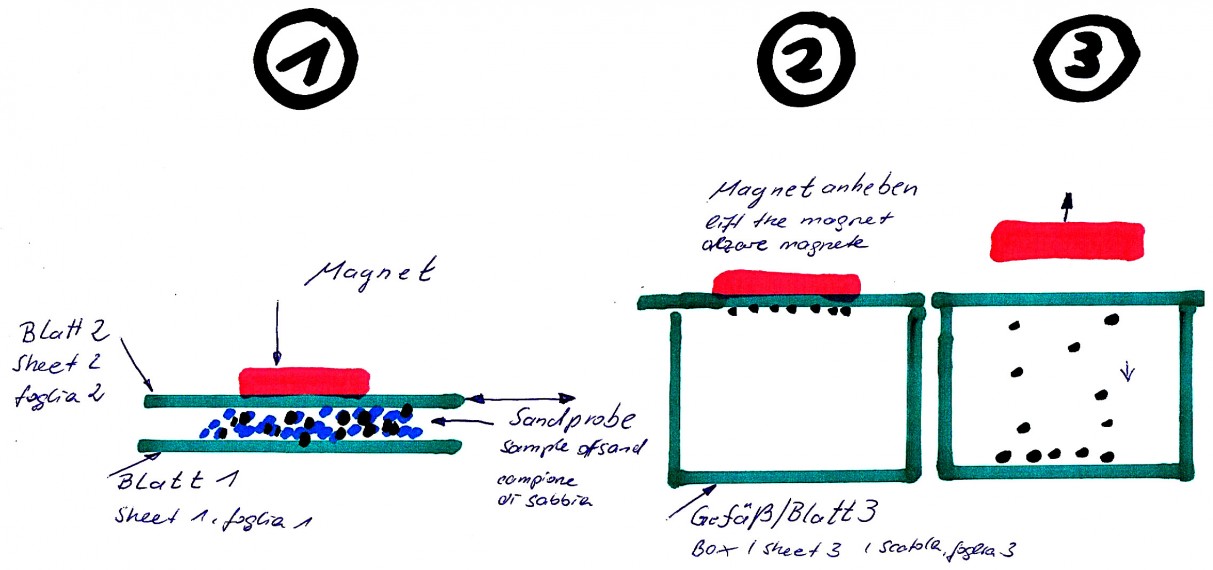Magnetic Sands in Giardini Naxos EarthCache
Magnetic Sands in Giardini Naxos
-
Difficulty:
-

-
Terrain:
-

Size:  (other)
(other)
Please note Use of geocaching.com services is subject to the terms and conditions
in our disclaimer.
- necessary equipment: Magnet, 2-3 sheets of paper, perhaps a small box, folding ruler or similar.
- attrezzatura necessaria: Magnete, 2-3 fogli di carta, forse una piccola scatola, righello o simili.
- notwendige Ausrüstung: Magnet, 2-3 Blatt Papier, evtl. eine kleine Schachtel, Zollstock o.ä.

Italiano:
Sabbia magnetica a Giardini Naxos
Immagina di essere nel centro del nostro pianeta Terra. Nel nucleo terrestre le temperature si aggirano sui 5500°C. Esso è composto da ferro e nickel e, mentre nel nucleo interno la pressione è così alta che gli elementi si trovano allo stato solido, nel nucleo esterno essi sono invece allo stato liquido. Nel mantello, che si estende fino a 2900 km in profondità e che presenta temperature di circa 2500°C, la roccia del nostro pianeta comincia a fondersi. Siccome la pressione a questa profondità è così alta, la roccia non passa allo stato liquido, bensì si trasforma in magma, che si comporta in modo simile alla gommapane. Solamente gli ultimi trenta chilometri, quelli della crosta terrestre, sono composti da roccia allo stato solido.

La crosta terrestre è costituita da un enorme puzzle di placche isolate, le quali si scontrano le une contro le altre; nei punti di confine si verificano sempre eruzioni vulcaniche. Durante tali eruzioni si ha spesso una violenta fuoriuscita di magma ferrugginoso.
Sotto particolari condizioni hanno anche origine formazioni di basalto, come nella parte superiore delle gole dell'Alcantara. Nel corso di milioni di anni, tramite un continuo processo di erosione, i pezzi di basalto più fini vengono separati e trasportati dal fiume nelle acque del mare. A pochi kilometri di distanza dalla nostra earthcache il fiume Alcantara sfocia nel Mar Mediterraneo.
I fini pezzi di basalto trasportati dal fiume giungono sulla spiaggia portati dalle correnti del mare e qui si fermano in quanto sono più pesanti della sabbia. Spesso si possono trovare nella forma assunta da composizioni ricche di ferro, come ad esempio fa la magnetite. Anche la stessa sabbia è magnetica. In questa spiaggia viene impedito ai pezzettini di tornare nuovamente in mare mediante una zona di ghiaia antistante.
La nostra earthcache ti conduce alla spiaggia Recanati, una delle spiagge di Giardini Naxos. La spiaggia è liberamente accessibile. L'accesso si può trovare direttamente vicino al parcheggio.
Per poter loggare la EC rispondi per favore alle sequenti domande:
1. Nella zona di sabbia fine sei in grado di trovare un'indicazione del fatto che tale spiaggia abbia della sabbia contenente tracce di ferro?
Prova a svolgere il seguente esperimento:

- Cerca un punto possibilmente scuro ma asciutto nella sezione di sabbia fine e prendine un campione grande quanto un cucchiaio, quindi ponilo sopra ad un foglio di carta.
- Poni un secondo foglio di carta sopra al primo, quindi appoggia sopra un magnete. Muovi ora il foglio soprastante con il magnete sopra il campione.
- Solleva ora il foglio superiore sempre lasciandovi sopra il magnete e ponilo sopra ad un terzo foglio di carta o ad un recipiente. Allontana il magnete. Nel contenitore o sopra il foglio troverai dei granelli scuri, questa è la prova della presenza di ferro nella sabbia.
2. Prendi in mano un campione dalla zona di ghiaia e descrivilo in relazione alla dimensione, alla forma dei granelli (lisci, ruvidi, curvi, spigolosi) e alla loro mescolanza di colori.
3. Alle coordinate del WP2 trovi la pietra raffigurata nello spoiler. Fornisci le sue dimensioni (lunghezza, larghezza ed altezza). E' una roccia di origine vulcanica? Motiva la tua risposta.
4. Facoltativo: ci farebbe molto piacere se allegassi una foto con l'Etna sullo sfondo.
Si prega di notare: Non è necessario che tu attenda il nostro consenso, puoi loggare subito, ma chiediamo di inviare assieme al log anche la mail con le risposte! Per favore evitare log del tipo "Invio più tardi le risposte quando sarò a casa, quando ho migliore connessione a Internet" o simili. Cancelleremo log di questo tipo senza alcun preavviso perché fino ad ora abbiamo dovuto quasi sempre domandare nuovamente noi stessi. Se non conoscete subito le risposte, per favore aspettate a loggare.
English:
Magnetic Sands in Giardini Naxos
Imagine you are in the center of the earth. In the earth's core it is about 5500°C hot. It consists of iron and nickel. Inside the inner core, the pressure is so high that the elements are in a solid form while in liquid form in the outer core. In the earth's mantle, which reaches down to a depth of 2900 kilometers and where the temperatures can reach up to 2500°C, the solid rock of our mother planet starts to melt. Because the pressure at this depth is so high it will not become liquid but instead becomes Magma. It behaves similarly to plasticine. Only the last thirty kilometers, called the earth's crust, consist of solid rock.

The earth's crust consists of a gigantic puzzle of individual plates which move against each other. The plates move again and again resulting in volcanic eruptions, ejecting ferruginous magma as a rule.
Under specific conditions, there can be formations of basalt, like in the upper part of the Gose Alcantara. Over millions of years, persistent erosion causes the finest particles to dissolve out of the basalt, which are then carried by the river into the sea. Just a few kilometers away from our Earth Cache flows the Fiume Alcantara into the Mediterranean Sea.
Those fine particles carried by the river are rinsed and deposited by sea currents onto the beach because they are heavier than other sands. They can be found in the form of iron-containing compounds, such as, for example, magnetite. Thus the sand is magnetic. At this beach the back rinsing of the particles into the sea is additionally prevented by an offshore gravel zone.
Our Earth Cache leads you to the beach Recanati, one of the beaches of Giardini Naxos. The beach is open for public. Access is available next the parking lot.
To log the EC please answer the following questions:
1. Can you find an indication of iron sand on the beach?
Please carry out therefore the following experiment:

- Look for a dark as possible but dry spot in the fine sandy section of the beach at the coordinates. Put a spoonful-size sample on a sheet of paper.
- Cover this sample with a second sheet of paper and put a magnet on top. Now move the upper sheet with the magnet over the sample of sand.
- Now lift the upper sheet together with the magnet and move it over a third sheet or a small box and remove the magnet. Can you find on the sheet, or in the box, dark granules? If so, you have provided the evidence for iron sand.
2. Take a sample from the gravel zone in your hand and describe it in relation of grain size (smooth, rough, round, square) and color mixture.
3. At the coordinates of Waypoint 2 you'll find the stone depicted at the spoiler photo. Please tell us its dimensions (Length, width and height). Is it a volcanic rock? What are your reasons?
4. Optional we would be very happy to see a photo of you with Mount Etna in the background.
Please note: You do not need wait for our permission, but send the answer Email immediately together with the log! No logs like: "Will send the answers later, when back home, when having better internet", etc. Such kind of logs we will delete without prior notification.
Für die deutsche Übersetzung klicke/for the german translation click hier/here.
Additional Hints
(No hints available.)